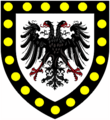William Killigrew (Chamberlain of the Exchequer) facts for kids
Sir William Killigrew (died 1622) was an important person in the royal courts of Queen Elizabeth I and King James I. He worked as a Groom of the Privy Chamber, which meant he was a close attendant to the monarch. He also served as a Member of Parliament (MP) for many years and was in charge of the royal money as Chamberlain of the Exchequer for a time. Many of his family members also worked for the royal family and are buried in Westminster Abbey.
Contents
Who Was Sir William Killigrew?
Sir William Killigrew was born into a well-known family from Cornwall, England. He was the fifth son of John III Killigrew, who was the first Governor of Pendennis Castle. This castle was built by King Henry VIII on land owned by the Killigrew family. His mother was Elizabeth Trewinnard. You can still see a special brass memorial for his father in St Budock's Church, near their family home.
Sir William's Career in Government
Working for Queen Elizabeth I
Sir William Killigrew had a long and active career in public service.
- In 1571, he was first elected as a Member of Parliament (MP) for Grantham.
- The next year, 1572, he became an MP for Helston in Cornwall.
- By 1576, he was given important roles in the Duchy of Cornwall, which is a special estate belonging to the royal family. He also became the Constable of Launceston Castle.
- Around the same time, he became a Groom of the Privy Chamber for Queen Elizabeth I. This was a trusted position, meaning he was a personal attendant to the Queen.
- He handled money matters, like collecting profits from legal documents in the courts.
- He also helped organize soldiers for Cornwall and served as a Justice of the Peace, helping to keep law and order.
- In 1584, he was elected MP for Penryn, a town where his family had a lot of influence.
- He continued to hold various important roles, including managing royal income for Devon and Cornwall.
- In 1593, he became MP for Fowey.
- He helped manage the royal treasury and dealt with valuable goods captured from Cadiz in 1596.
- His importance grew, and in 1597, he was elected MP for the entire county of Cornwall, which was a very respected position.
Working for King James I
When King James I took the throne in 1603, Sir William Killigrew was knighted, which means he was given the title "Sir."
- In 1604, he became an MP for Liskeard.
- From 1605 to 1608, he served as the Chamberlain of the Exchequer. This was a very important job where he managed the royal finances.
- In 1614, he was again elected as MP for Penryn.
Sir William's Family Life
Around 1576, Sir William Killigrew married Margaret Saunders. She had been married before. Together, they had several children:
- Sir Robert Killigrew (1580–1633): He followed in his father's footsteps, becoming an MP and serving Queen Henrietta Maria as her Vice-Chamberlain.
- Elizabeth Killigrew: She was the eldest daughter and married Sir Maurice Berkeley, who was also an MP.
- Catherine Killigrew (born 1579): She married Sir Thomas Jermyn. Their son, Henry Jermyn, 1st Earl of Saint Albans, became a very important person in the royal court. There is a famous painting of Catherine by Marcus Gheeraerts the Younger that you can see at the Yale Center for British Art in the USA.
Where Sir William Lived
In 1594, Sir William Killigrew leased two royal estates called Kempton and Hanworth in Middlesex for 80 years. Later, his son, Sir Robert Killigrew, took over the lease. Eventually, Sir William's grandson, also named Sir William Killigrew, sold Kempton Park in 1651.
Death and Burial
Sir William Killigrew passed away in 1622. He was buried in St. Margaret's Church in the City of London, close to his brother, Henry Killigrew.
Images for kids
-
Modern arms of Killigrew: Argent, an eagle displayed with two heads sable a bordure of the second bezantée. The bezantée bordure indicates a connection to the ancient Earls of Cornwall
-
Catherine Killigrew (born 1579) (Lady Jermyn), at age 35, daughter of Sir William Killigrew and wife of Sir Thomas Jermyn (died 1645). 1614 Portrait by Marcus Gheeraerts the Younger (1561–1636), Yale Center for British Art, Connecticut





